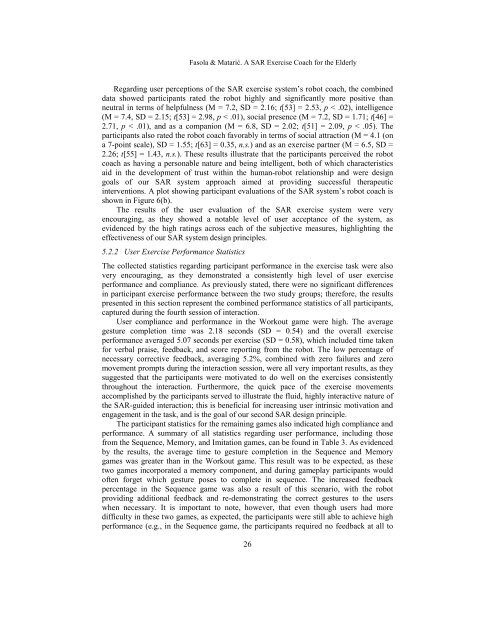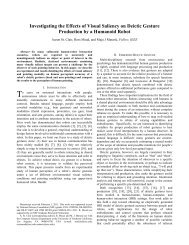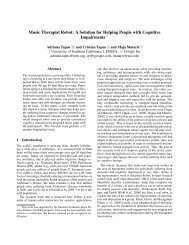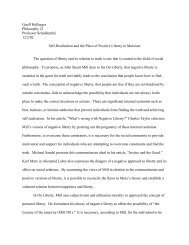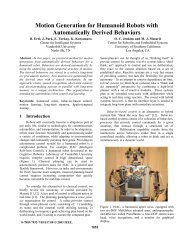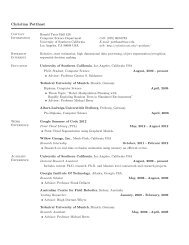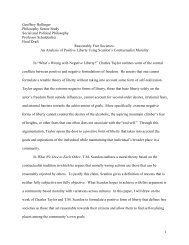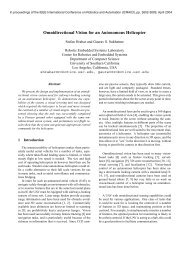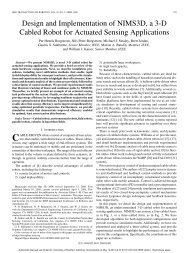A Socially Assistive Robot Exercise Coach for the Elderly
A Socially Assistive Robot Exercise Coach for the Elderly
A Socially Assistive Robot Exercise Coach for the Elderly
You also want an ePaper? Increase the reach of your titles
YUMPU automatically turns print PDFs into web optimized ePapers that Google loves.
Fasola & Matarić. A SAR <strong>Exercise</strong> <strong>Coach</strong> <strong>for</strong> <strong>the</strong> <strong>Elderly</strong>Regarding user perceptions of <strong>the</strong> SAR exercise system’s robot coach, <strong>the</strong> combineddata showed participants rated <strong>the</strong> robot highly and significantly more positive thanneutral in terms of helpfulness (M = 7.2, SD = 2.16; t[53] = 2.53, p < .02), intelligence(M = 7.4, SD = 2.15; t[53] = 2.98, p < .01), social presence (M = 7.2, SD = 1.71; t[46] =2.71, p < .01), and as a companion (M = 6.8, SD = 2.02; t[51] = 2.09, p < .05). Theparticipants also rated <strong>the</strong> robot coach favorably in terms of social attraction (M = 4.1 (ona 7-point scale), SD = 1.55; t[63] = 0.35, n.s.) and as an exercise partner (M = 6.5, SD =2.26; t[55] = 1.43, n.s.). These results illustrate that <strong>the</strong> participants perceived <strong>the</strong> robotcoach as having a personable nature and being intelligent, both of which characteristicsaid in <strong>the</strong> development of trust within <strong>the</strong> human-robot relationship and were designgoals of our SAR system approach aimed at providing successful <strong>the</strong>rapeuticinterventions. A plot showing participant evaluations of <strong>the</strong> SAR system’s robot coach isshown in Figure 6(b).The results of <strong>the</strong> user evaluation of <strong>the</strong> SAR exercise system were veryencouraging, as <strong>the</strong>y showed a notable level of user acceptance of <strong>the</strong> system, asevidenced by <strong>the</strong> high ratings across each of <strong>the</strong> subjective measures, highlighting <strong>the</strong>effectiveness of our SAR system design principles.5.2.2 User <strong>Exercise</strong> Per<strong>for</strong>mance StatisticsThe collected statistics regarding participant per<strong>for</strong>mance in <strong>the</strong> exercise task were alsovery encouraging, as <strong>the</strong>y demonstrated a consistently high level of user exerciseper<strong>for</strong>mance and compliance. As previously stated, <strong>the</strong>re were no significant differencesin participant exercise per<strong>for</strong>mance between <strong>the</strong> two study groups; <strong>the</strong>re<strong>for</strong>e, <strong>the</strong> resultspresented in this section represent <strong>the</strong> combined per<strong>for</strong>mance statistics of all participants,captured during <strong>the</strong> fourth session of interaction.User compliance and per<strong>for</strong>mance in <strong>the</strong> Workout game were high. The averagegesture completion time was 2.18 seconds (SD = 0.54) and <strong>the</strong> overall exerciseper<strong>for</strong>mance averaged 5.07 seconds per exercise (SD = 0.58), which included time taken<strong>for</strong> verbal praise, feedback, and score reporting from <strong>the</strong> robot. The low percentage ofnecessary corrective feedback, averaging 5.2%, combined with zero failures and zeromovement prompts during <strong>the</strong> interaction session, were all very important results, as <strong>the</strong>ysuggested that <strong>the</strong> participants were motivated to do well on <strong>the</strong> exercises consistentlythroughout <strong>the</strong> interaction. Fur<strong>the</strong>rmore, <strong>the</strong> quick pace of <strong>the</strong> exercise movementsaccomplished by <strong>the</strong> participants served to illustrate <strong>the</strong> fluid, highly interactive nature of<strong>the</strong> SAR-guided interaction; this is beneficial <strong>for</strong> increasing user intrinsic motivation andengagement in <strong>the</strong> task, and is <strong>the</strong> goal of our second SAR design principle.The participant statistics <strong>for</strong> <strong>the</strong> remaining games also indicated high compliance andper<strong>for</strong>mance. A summary of all statistics regarding user per<strong>for</strong>mance, including thosefrom <strong>the</strong> Sequence, Memory, and Imitation games, can be found in Table 3. As evidencedby <strong>the</strong> results, <strong>the</strong> average time to gesture completion in <strong>the</strong> Sequence and Memorygames was greater than in <strong>the</strong> Workout game. This result was to be expected, as <strong>the</strong>setwo games incorporated a memory component, and during gameplay participants wouldoften <strong>for</strong>get which gesture poses to complete in sequence. The increased feedbackpercentage in <strong>the</strong> Sequence game was also a result of this scenario, with <strong>the</strong> robotproviding additional feedback and re-demonstrating <strong>the</strong> correct gestures to <strong>the</strong> userswhen necessary. It is important to note, however, that even though users had moredifficulty in <strong>the</strong>se two games, as expected, <strong>the</strong> participants were still able to achieve highper<strong>for</strong>mance (e.g., in <strong>the</strong> Sequence game, <strong>the</strong> participants required no feedback at all to26


